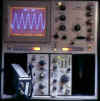|
|
|
My friend please don't complain or laugh about the quality of my english, I'am not born under the union jack or the stars and stripes. Ok - you can smile if your german has the some quality like my german. The circiut comes from the website http://www.qsl.net/dk6rx/fnorm/fnorm.htm I want to show this circiut as a part of my test equipment collection, it's an affordable second source frequency standard instead of an big, fat and still expensive caesium, rubidium or GPS frequency standard. The theory of operation, specification and details of the circiut are described on the designers website. He also describe why it's necessary to choose the correct TV-Station, for Germany it's the ZDF. Features:
|
|
applications?to calibrate some of these test equipment: HP3325A frequency generator (with ovenquartz) HP3336B sine level synthesizer (standard quartz) HP5335A counter (standard quartz) HP3586C selective voltmeter (standard quartz) On all connected instruments the reference input triggers without any problems even without termination. If somebody wish a 50 Ohm termination for using a long coaxial cable - use a video operational amplifier as buffer and create a 50 Ohm source impedance. But the low power consumption of the circiut will be degraded, these kind of amp's take normally their milliamperes. I don't wanted to use a AC power supply. |
|
How to adjust?One possibility to adjust - use an two channel scope. This makes it easy to see the circiut working and it's a quit simple procedure to adjust your test equipment reference quartz. Channel A triggers on the 10MHz output of the normal, channel B displays the free running reference output of your test equipment. Adjust the quartz until channel B stands still on the scope. If you have some instruments with different quartz stability, this calibration procedure make it easy to see how stable they are. A good ovenquartz remains still standing for a long time. Never a bad word about an caesium normal, it's nice to have one. They are a beauty for every designer. I also like to be the owner of one - no - after thinking about this - not for me, I'am doing my work with audio amplifier applications and a caesium normal would be absolutely overpowerded. |
|
How accurate is this circiut?I can't tell you, it's already my most stable and accurate frequency source. If somebody checked this normal under an caesium normal, I would be be glad to see your results. |
|





